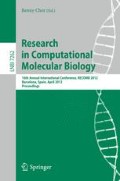Abstract
Modeling loops is a necessary step in protein structure determination even with experimental NMR data. It is well known to be difficult. Database techniques have the advantage of producing a higher proportion of predictions with sub-angstrom accuracy, when compared with ab initio techniques, but the disadvantage of also producing a higher proportion of clashing or highly inaccurate predictions. We introduce LoopWeaver, a database method that uses multidimensional scaling to achieve better clash-free placement of loops obtained from a database of protein structures. This allows us to maintain the above-mentioned advantage while avoiding the disadvantage. Test results show that we achieve significantly better results than all other methods, including Modeler, Loopy, SuperLooper, and Rapper before refinement. With refinement, our results (LoopWeaver and Loopy consensus) are better than ROSETTA, with 0.42Å RMSD on average for 206 length 6 loops, 0.64Å local RMSD for 168 length 7 loops, 0.81Å RMSD for 117 length 8 loops, and 0.98Å RMSD for length 9 loops, while ROSETTA has 0.55, 0.79, 1.16, 1.42, respectively, at the same average time limit (3 hours). When we allow ROSETTA run for over a week, it approaches, but does not surpass, our accuracy.
Access this chapter
Tax calculation will be finalised at checkout
Purchases are for personal use only
Preview
Unable to display preview. Download preview PDF.
References
de Bakker, P.I.W., DePristo, M.A., Burke, D.F., Blundell, T.L.: Ab initio construction of polypeptide fragments: Accuracy of loop decoy discrimination by an all-atom statistical potential and the amber force field with the generalized born solvation model. Proteins: Structure, Function, and Bioinformatics 51, 21–40 (2003), http://dx.doi.org/10.1002/prot.10235
Basalaj, W.: Proximity visualization of abstract data. Technical report, University of Cambridge Computer Laboratory (2001), http://pavis.org
Choi, Y., Deane, C.M.: Fread revisited: Accurate loop structure prediction using a database search algorithm. Proteins: Structure, Function, and Bioinformatics 78(6), 1431–1440 (2010)
Cohen, J.D.: Drawing graphs to convey proximity: an incremental arrangement method. ACM Trans. Comput.-Hum. Interact. 4, 197–229 (1997), http://doi.acm.org/10.1145/264645.264657
Deane, C.M., Blundell, T.L.: Coda: A combined algorithm for predicting the structurally variable regions of protein models. Protein Science 10(3), 599–612 (2001)
Fiser, A., Do, R., Sali, A.: Modeling of loops in protein structures. Protein Science 9(9), 1753–1773 (2000)
Fiser, A., Sali, A.: Modeller: Generation and refinement of homology-based protein structure models. In: Charles, W., Carter, J., Sweet, R.M. (eds.) Macromolecular Crystallography, Part D. Methods in Enzymology, vol. 374, pp. 461–491. Academic Press (2003), http://www.sciencedirect.com/science/article/B7CV2-4BT8FSC-R/2/efdaef0eaf06a1c59521dd71f7612a91
Hildebrand, P.W., Goede, A., Bauer, R.A., Gruening, B., Ismer, J., Michalsky, E., Preissner, R.: SuperLoopera prediction server for the modeling of loops in globular and membrane proteins. Nucleic Acids Research 37(suppl. 2), W571–W574 (2009), http://nar.oxfordjournals.org/content/37/suppl_2/W571.abstract
Kabsch, W., Sander, C.: Dictionary of protein secondary structure: Pattern recognition of hydrogen-bonded and geometrical features. Biopolymers 22(12), 2577–2637 (1983), http://dx.doi.org/10.1002/bip.360221211
Lee, J., Lee, D., Park, H., Coutsias, E.A., Seok, C.: Protein loop modeling by using fragment assembly and analytical loop closure. Proteins: Structure, Function, and Bioinformatics 78(16), 3428–3436 (2010), http://dx.doi.org/10.1002/prot.22849
de Leeuw, J.: Applications of Convex Analysis to Multidimensional Scaling. In: Barra, J., Brodeau, F., Romier, G., van Cutsem, B. (eds.) Recent Developments in Statistics, pp. 133–146. North Holland Publishing Company (1977)
Mandell, D.J., Coutsias, E.A., Kortemme, T.: Sub-angstrom accuracy in protein loop reconstruction by robotics-inspired conformational sampling. Nat. Methods 6(8), 551–552 (2009), http://dx.doi.org/10.1038/nmeth0809-551
Mandell, D.J., Pache, R.A.: Rosetta projects: Documentation for kinematic loop modeling (October 2011), http://rosettacommons.org/manuals/archive/rosetta3.3_user_guide/app_kinematic_loopmodel.html
Michalsky, E., Goede, A., Preissner, R.: Loops In Proteins (LIP)-a comprehensive loop database for homology modelling. Protein Engineering 16(12), 979–985 (2003), http://peds.oxfordjournals.org/content/16/12/979.abstract
Soto, C.S.S., Fasnacht, M., Zhu, J., Forrest, L., Honig, B.: Loop modeling: sampling, filtering, and scoring. Proteins (August 2007), http://dx.doi.org/10.1002/prot.21612
Wang, C., Bradley, P., Baker, D.: Protein-protein docking with backbone flexibility. Journal of Molecular Biology 373(2), 503–519 (2007), http://www.sciencedirect.com/science/article/pii/S0022283607010030
Wang, G., Dunbrack, R.L.: PISCES: a protein sequence culling server. Bioinformatics 19(2), 1589–1591 (2003)
Xiang, Z., Soto, C.S., Honig, B.: Evaluating conformational free energies: The colony energy and its application to the problem of loop prediction. Proceedings of the National Academy of Sciences of the United States of America 99(17), 7432–7437 (2002), http://www.pnas.org/content/99/11/7432.abstract
Xu, J.: Rapid Protein Side-Chain Packing via Tree Decomposition. In: Miyano, S., Mesirov, J., Kasif, S., Istrail, S., Pevzner, P.A., Waterman, M. (eds.) RECOMB 2005. LNCS (LNBI), vol. 3500, pp. 423–439. Springer, Heidelberg (2005)
Xu, J., Berger, B.: Fast and accurate algorithms for protein side-chain packing. J. ACM 53, 533–557 (2006)
Zhang, C., Liu, S., Zhou, Y.: Accurate and efficient loop selections by the dfire-based all-atom statistical potential. Protein Science 13(2), 391–399 (2004), http://dx.doi.org/10.1110/ps.03411904
Zhang, J., Wang, Q., Barz, B., He, Z., Kosztin, I., Shang, Y., Xu, D.: Mufold: A new solution for protein 3d structure prediction. Proteins: Structure, Function, and Bioinformatics 78, 1137–1152 (2010)
Zhou, H., Zhou, Y.: Distance-scaled, finite ideal-gas reference state improves structure-derived potentials of mean force for structure selection and stability prediction. Protein Science 11, 2714–2726 (2002)
Zhu, K., Pincus, D.L., Zhao, S., Friesner, R.A.: Long loop prediction using the protein local optimization program. Proteins: Structure, Function, and Bioinformatics 65, 438–452 (2006)
Author information
Authors and Affiliations
Editor information
Editors and Affiliations
Rights and permissions
Copyright information
© 2012 Springer-Verlag Berlin Heidelberg
About this paper
Cite this paper
Holtby, D., Li, S.C., Li, M. (2012). LoopWeaver – Loop Modeling by the Weighted Scaling of Verified Proteins. In: Chor, B. (eds) Research in Computational Molecular Biology. RECOMB 2012. Lecture Notes in Computer Science(), vol 7262. Springer, Berlin, Heidelberg. https://doi.org/10.1007/978-3-642-29627-7_11
Download citation
DOI: https://doi.org/10.1007/978-3-642-29627-7_11
Publisher Name: Springer, Berlin, Heidelberg
Print ISBN: 978-3-642-29626-0
Online ISBN: 978-3-642-29627-7
eBook Packages: Computer ScienceComputer Science (R0)

